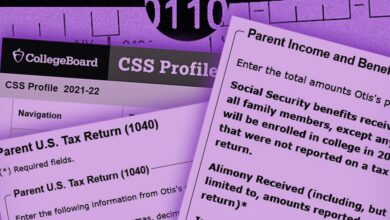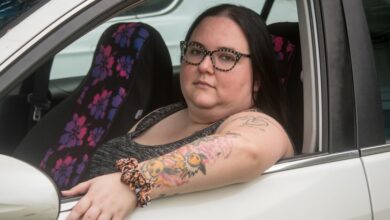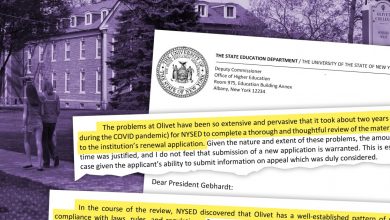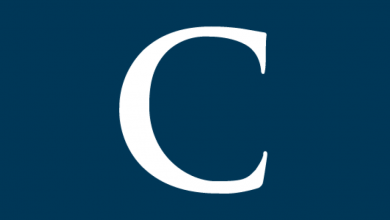Omicron Is Here and Colleges Are Scrambling

[ad_1]
It happened in a similar way at Cornell, Georgetown, and Northeastern Universities. First, genetic-sequencing teams detected one or a few cases of Omicron — the Covid-19 variant quickly spreading across the globe — among the positive tests on campus. Then came a boom in cases, many of which were Omicron, which is believed to be more transmissible than Delta, the dominant variant in the United States.
The variant’s quick spread has raised worries about colleges’ capacity to isolate and contact-trace positive cases.
Northeastern tallied an average of 23 daily positive cases last week, and then 50 on Monday alone. On Wednesday, Georgetown saw its largest single-day, new-case total of the pandemic, 34. And Cornell recently registered more than 900 active cases, prompting the university to move finals online and halt in-person activity.
At Georgetown and Northeastern, at least half of recent positive cases show preliminary signs that they’re the Omicron variant, said Ranit Mishori, chief public health officer at Georgetown, and Jared Auclair, technical supervisor for the coronavirus testing lab at Northeastern. Those samples still need to be verified through full genetic sequencing. At Cornell, researchers fully genetically sequenced a sample of positive tests from last weekend. Ninety percent of them were Omicron.
The current spread of the coronavirus is “different from any other time in the pandemic at Cornell,” said Peter I. Frazier, a professor of engineering who does mathematical modeling for the administration’s anti-Covid planning efforts.
On at least a handful of college campuses, Omicron has arrived. Although they have not reported serious illness among students, these colleges are seeing rapid spread that seems to dodge precautions that worked reasonably well before the advent of Omicron, including very high rates of vaccination. At Cornell, 97 percent of the on-campus population is fully vaccinated. Between December 7 and 13, 98 percent of infections were among the fully vaccinated, Frazier said.
Vaccinated people’s vulnerability to these infections may reflect their shots’ waning effectiveness as they hit the six-month mark, Mishori said. A booster shot could re-up their immunity. Other experts The Chronicle spoke with pointed to the possibility that in communities with high virus transmission, people may be exposing themselves to the coronavirus frequently enough that it breaks through their vaccine protection.
The new surge’s dynamics have raised worries about having enough capacity to isolate and contact-trace positive cases, in case Omicron spreads quickly and causes huge case numbers. Early studies suggest the variant may cause milder symptoms than other variants of the coronavirus, and vaccination seems to provide longer-lasting protection against hospitalizations and deaths.
But that’s no reason to let the virus run free, university leaders say. “The more cases you have, the more chances you have to infect people who are at risk, and our community, or any community, has a lot of them, whether they’re old, immunocompromised, or have other high-risk conditions,” Mishori said. “Yes, it’s a smaller proportion of our community, but we certainly have high-risk individuals who, if many more people around them are sick, it puts them at high risk. And then we would see more hospitalizations and more deaths.”
Beyond Cornell, Georgetown, and Northeastern, over the past week, several other colleges have reported case surges or the presence of Omicron on campus, or both. More campus outbreaks may appear in the coming days, said Georges C. Benjamin, executive director of the American Public Health Association. These surges may be driven by the Delta or Omicron variants or both, Benjamin predicted.
If American higher ed squeaks by without another reported outbreak, it’ll be because so many colleges are already letting out for winter break. That looming break is a relief, Mishori said. At Georgetown, as at Cornell, students who tested positive are currently isolating on campus. Some may not be able to leave for the holidays. Everyone else is encouraged to take a test and then head to their destination. Over the break, leaders can regroup and consider what Covid-19 protocols they’ll need for the spring of 2021.
And they’ll need strong ones. Modeling from the Centers for Disease Control and Prevention suggests that the country may see a large wave of infections as soon as January, just as college students are returning for the next term. Stanford University has already announced it will begin its winter quarter, which starts January 3, with two weeks of online instruction.
Neither Frazier nor Mishori were yet ready to share specifics about spring; Mishori mentioned having meetings planned throughout the break. Anita Barkin, co-chair of the American College Health Association’s Covid-19 task force, had a series of suggestions. Colleges need to make sure as many of their students as possible are vaccinated against the flu, and vaccinated and boosted against Covid-19. “That is the best path to trying to mitigate this new surge,” she said. The association has previously recommended colleges mandate a primary series of Covid-19 vaccines for their students, but it has not yet recommended that such mandates include a booster. Association leaders are now in “serious discussion” about adding boosters to their suggested mandate, Barkin said.
Colleges should also maintain a familiar set of strategies, Barkin said: indoor mask mandates and limits on large indoor gatherings.
[ad_2]
Source link






